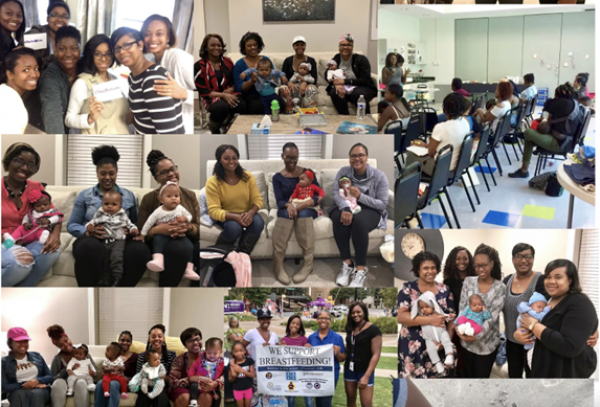
Breastfeeding and human milk are the normative standards for infant feeding and nutrition. The solid evidence of short- and long-term medical and neurodevelopmental advantages of breastfeeding make promoting, protecting, and supporting chest/breastfeeding a public health imperative. Leading health authorities recommend exclusive breastfeeding for the first six months after birth and continued breastfeeding, along with appropriate complementary foods introduced for two years or beyond. Although overall breastfeeding rates have increased through the past decade, persistent disparities still exist, with babies from Black, Indigenous, and People of Color (BIPOC) families having consistently lower exclusivity and duration rates. These are due to several unjust structural barriers, including lack of continuity of care in skilled lactation support, especially in BIPOC communities.
The Maternal, Child, and Adolescent Health program at NACCHO, through the Reducing Breastfeeding Disparities through Continuity of Care project, funded by CDC, works to improve community health through improved access to skilled lactation support in BIPOC communities. For the past four years, the NACCHO team has provided technical assistance to CDC Racial and Ethnic Approaches to Community Health (REACH) recipients working to improve continuity of care in breastfeeding support in their communities. In addition, last summer, NACCHO convened over 100 professionals across the country, in partnership with the U.S. Breastfeeding Committee, and launched the Continuity of Care (CoC) in Breastfeeding Support: A Blueprint for Communities. From November 2021 to July 2022, NACCHO awarded 10 local-level organizations to implement at least two Blueprint recommendations with local partners in their communities. Their successes will be showcased along with the one year anniversary of the CoC Blueprint on August 24.
NACCHO has also hosted the Continuity of Care Blueprint eight part webinar series, Every Step of the Way Through the First 1,000 Days, showcasing successful Blueprint implementations and CoC stories in REACH communities. Our next webinar will focus on Building Community Workforce Capacity to Equitably Support Chest/Breastfeeding and will take place on September 13. Register here.
August is National Breastfeeding Month (NBM) and this year’s theme is Together We Can Do Great Things, emphasizing the importance of working together to help families and communities achieve optimal health. This theme is very timely, since no organization alone can establish continuity of care in breastfeeding support within a community. It takes a multisector collective approach to effectively ensure families meet their chest/breastfeeding goals. Together, local partners and lactation support providers can build a lactation safety net, through a coordinated, comprehensive care stream and consistent availability of lactation-supportive environments that fully supports the entire family unit throughout the first 1,000 days in each community.
Each week in August is dedicated to a specific community and theme, as outlined below:
- Week 1: World Breastfeeding Week, Step up for Breastfeeding: Educate & Support
- Week 2: Indigenous Milk Medicine Week, Strengthening Our Traditions From Birth and Beyond
- Week 3: Asian American Native Hawaiian and Pacific Islander Breastfeeding Week, Telling Our Own Stories. Elevating Our Voices
- Week 4: Black Breastfeeding Week, BBW 2022: 10 Years, A New Foundation
We hope you will take advantage of all these great resources and celebrate with us. Happy National Breastfeeding Month!
Main Photo Source: Picture from Blueprint implementation project grantee Queen City C.O.C.O.A Beans, NC
References:
American Academy of Pediatrics. (2022). Breastfeeding and the use of human milk.
American Public Health Association. (2013). An update to A call to action to support breastfeeding: A fundamental public health issue.
Centers for Disease Control and Prevention. (2013). Strategies to prevent obesity and other chronic diseases: the CDC guide to strategies to support breastfeeding mothers and babies.
World Health Organization. (2003). Glob-al strategy for infant and young child feeding.
Horta, B. (2013). Long-term effects of breastfeeding: a systematic review. World health organization.
Dieterich et al. (2013). Breastfeeding and health outcomes for the mother-infant dyad. Pediatric Clinics of North Ameri-ca, 60(1), 31–48.7
Rollins NC, et al. (2016). Why invest, and what it will take to improve breastfeeding practices? Lancet, 387(10017), 491–504.



